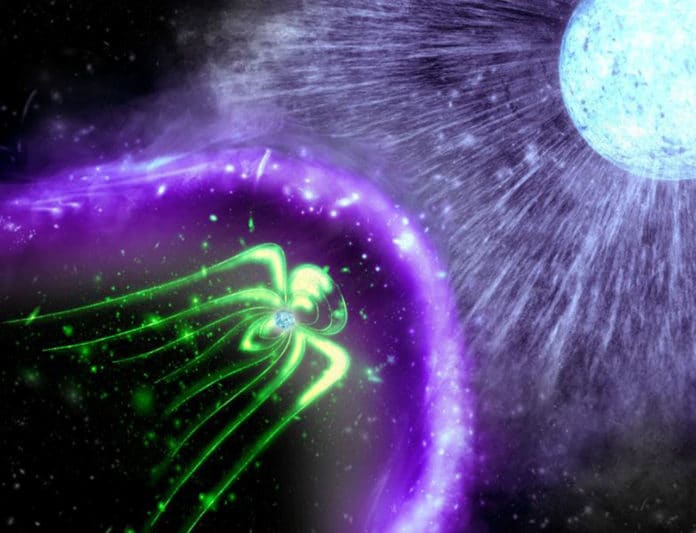Gamma-ray binaries are a system of massive, high-energy stars and compact stars. They appear bright bluish-white stars when observing with visible light. When observing X-rays and gamma-rays, their properties differ drastically from those of other binaries.
Once the gamma-ray binaries were established as a new astrophysical class, it was quickly recognized that an extremely efficient acceleration mechanism should operate in them. Some gamma-ray binaries are known to emit strong gamma-rays with energies of several megaelectron volts (MeV).
Such gamma rays are quite challenging to observe as they were detected from only around 30 celestial bodies in the whole sky.
But, what’s mysterious is that such binaries emit strong radiation even in this energy band. This means a beneficial particle acceleration process must be going on within them.
The past few studies made it clear that a gamma-ray binary is generally made of a massive primary star that weighs 20-30 times the Sun’s mass and a companion star that must be compact. But, it remains unclear whether the close star is a black hole or a neutron star.
Scientists at the Kavli Institute for the Physics and Mathematics of the Universe (Kavli IPMU) have studied previously collected data to infer the nature of a magnetar orbiting within LS 5039, the brightest gamma-ray binary system in the Galaxy. Scientists focused on LS 5039 because of its position as the brightest gamma-ray binary in the X-rays and gamma-ray range.
Earlier, it was thought that the LS 5039 must have a neutron star because of its stable X-ray and TeV gamma-ray radiation. However, until now, attempts to detect such pulses had been conducted with radio waves and soft X-rays—and because radio waves and soft X-rays are affected by the primary star’s stellar winds, detection of such periodical pulses had not been successful.
Now, for the first time, scientists focused on the hard X-ray band (>10 keV) and observation data from LS 5039 gathered by the hard X-ray detector (HXD). The data was collected from the space-based telescopes Suzaku (between September 9 and 15, 2007) and NuSTAR (between September 1 and 5, 2016).
Both observations provided evidence on the presence of a neutron star within the core of LS 5039:the periodic signal from Suzaku with a period of about 9 seconds. The probability that this signal arises from statistical fluctuations is only 0.1 percent. NuSTAR also showed a very similar pulse signal. Combining these results also inferred that the spin period is increasing by 0.001 s every year.
Based on the derived spin period and the rate of its increase, the group precluded the rotation powered and accretion- powered scenarios. They found that the neutron star’s magnetic energy is the sole energy source that can power LS 5039.
The required magnetic field reaches 1011 T, three orders of magnitude higher than those of typical neutron stars. This value is found among so-called magnetars, a subclass of neutron stars with such a powerful magnetic field.
The pulse period of 9 seconds is typical of magnetars. This strong magnetic field prevents the primary star’s stellar wind from being captured by a neutron star, explaining why LS 5039 does not exhibit properties similar to X-ray pulsars.
Strangely, the 30 magnetars that have been found so far have all been seen as isolated stars, so their existence in gamma-ray binaries was not viewed as a standard idea. Other than this new theory, the group recommends a source that powers the non-thermal emission inside LS 5039—they suggest that the emission is caused by a collaboration between the magnetar’s magnetic fields and dense stellar winds. Indeed, their figurings recommend that gamma-rays with energies of several megaelectronvolts, which has been unclear, can be unequivocally emitted if they are produced in a region of a powerful magnetic field, close to a magnetar.
These results potentially settle the mystery of the compact object’s nature within LS 5039 and the underlying mechanism powering the binary system. However, further observations and refining of their research are needed to shed new light on their findings.
Journal Reference:
- Hiroki Yoneda et al. Sign of hard X-ray pulsation from the gamma-ray binary system LS 5039. DOI: 10.1103/PhysRevLett.125.111103
